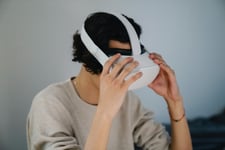Sweden-based Configura announces a collaboration with Toronto-based Yulio to bring a mobile virtual reality experience to thousands of interior designers and customers around the globe. Yulio is a DIY virtual reality platform for those in the business of designing spaces. The technology enables 3D designs to be turned into rich, immersive 360-degree VR experiences with just a few clicks. The VR experiences can be shared directly to clients’ smartphones or other devices for viewing. Livestream collaboration functionality lets designers walk and talk clients through their designs. “Democratizing VR and ‘baking it into the workflow’ is an extremely inexpensive way to improve the client experience,” Yulio’s founder and Managing Director Rob Kendal said Configura – known for its CET Designer space-planning software used by such global office furniture giants as Steelcase, Haworth and Herman Miller – partnered with Yulio to democratize the use of virtual reality in interior design. Yulio’s “3D to VR software” plugin – available as a CET Designer Extension – takes what was once a pricey proposition and makes it an affordable, easy and agile experience. The collaborative technology recently launched with the release of CET Designer 7.5. The Yulio Extension in CET Designer is free. The Yulio subscription service is as low as $20 per month for a single user account, which can enable virtually unlimited usage for dealerships. Yulio offers a free 30-day trial in which users can sign up online, download the Extension and immediately begin using Yulio. “The technology makes it so cost-effective and simple to use that you can’t afford not to use it,” says Configura Chief Product Officer Nicklas Dagersten.
Democratizing design
Virtual reality is nothing new to the gaming and entertainment world where it first took off commercially. But VR is now spreading into all kinds of industries – including the interior design profession and particularly in the contract furniture market where customers want to experience their workspace before purchasing products. Until recently, VR in interior design has been costly, with high-end VR headsets hovering around $600 USD. Meanwhile, Google Cardboard and Homido MINI products can be sourced for around $15 USD per headset. Software such as CET Designer in combination with Yulio enable an immersive experience that includes specific products and details – brands, colors, materials, lighting, flooring and accessories. “For an architect or designer, viewing an image of a 3D space may be enough to fully visualize the space. Yet this isn’t the case for many of their clients,” Kendal says. “Yulio and Configura bridge this communication gap – placing the customer directly into the VR design and creating certainty in what was previously often a guessing game.”
How it works:
- An interior designer (or architect, specifier, salesperson, facilities manager, etc.) uses CET Designer to create a space in 3D, dragging and dropping actual office furniture products into place.
- When satisfied with the design, the designer renders the drawings using the Yulio Extension. The rendered output takes the form of a “cube map” and is automatically uploaded to the Yulio cloud.
- The designer shares the cube map with one click, directly to the client’s preferred viewing device – a smartphone, tablet or computer. The customer can view the space directly on the device as a 360-degree panoramic scene – what Yulio calls “fishbowl VR” – or enhance the experience with virtual reality by downloading the Yulio Viewer app (available for iOS, Android and Samsung Gear VR) to a smartphone, and then using the app in conjunction with a VR headset such as Google Cardboard or Homido MINI.
- The designer sees what the customer sees as they’re guided through the VR space. With remote collaboration functionality, designer and client can be anywhere in the world.
Live collaboration
Live collaboration is activated through live.yulio.com. Kendal explains: “It’s as easy as a designer saying to a customer over the phone, ‘Let me run some ideas by you.’ The designer gives the customer the Yulio URL, and is now able to facilitate a live collaboration where the host can see what the viewer is looking at. It allows is a fully moderated experience where the designer can walk clients through different parts of the design.” The technology works with Revit and other major industry CAD tools, which means entire buildings of designed space can be experienced in VR. Yulio’s technology also can be embedded on a user’s own website, where an entire portfolio of VR and fishbowl VR experiences can be shared with clients and potential clients. “We’re solving real business problems with a real-world tool that is available now,” Dagersten says. For designers who want to offer their clients the ability to literally “walk around” in a virtually designed space – down corridors, along hallways and so forth – there’s Configura’s Virtual Viewer VR. The Virtual Viewer VR Extension offers full support for the Oculus Rift virtual reality headset. Virtual reality for CET Designer was the first immersive, industry-wide VR solution introduced on the market that supports multiple manufacturers’ products and then allows the furniture buyer to virtually walk through their space before they purchase. CET Designer supports more than 100 manufacturers’ product lines through different Extensions.
Better process, faster decisions
Firms who are already using VR report that it helps clients make design-related decisions in a fraction of the time that it would usually take them – in fact, shortening the design and collaboration process by up to 50 percent, according to Kendal. “Designers and their clients are using VR to predict design errors before a project actually begins construction, making for a much smoother construction phase,” he said. Some firms have taken their VR services one step further, building entirely new revenue streams based on this technology. For example, using Yulio’s technology, a Toronto-based design firm has begun creating VR designs to help clients of a major national real estate company visualize otherwise empty apartment spaces. Where the real estate company previously would have spent $50-$60 per square foot building actual model apartments, VR is a fast and economical alternative. According to Kendal, “Virtually all of the major architectural and design organizations are actively investigating and using VR technology. Of course, the ‘wow’ factor that comes with the medium is giving early adopters a critical advantage at this point – we’ve lost count at the number of ‘wins’ attributed to a pair of goggles.”
Learn more about how virtual reality is changing the architecture and design industry in this blog post by Yulio: https://yulio.com/2016/10/10/2-ways-virtual-reality-is-changing-the-architecture-and-design-industries/ Experience various Yulio demos here: https://www.yulio.com/showcase/. View an example of an office space at https://www.yulio.com/OGZQk2X5ke. View an example of a kitchen space at: https://www.yulio.com/khxWG4slBo. Watch the video: https://youtu.be/bJBt0eYRcQw. Configura’s Kelsey DeBruin explains how Yulio works with CET Designer in this short video: https://drive.google.com/open?id=0B7kP4AuUc3-cWGM5ZEljVkhFbGM Configura’s Kelsey DeBruin interviews Yulio Chief Product Officer Iain Hall and demos CET Designer and Yulio during a Facebook Live event on Thursday, Jan. 19, 11 a.m. ET at www.facebook.com/cetdesigner.


.jpg?width=245&height=150&name=active-adult-beautiful-1799244%20(1).jpg)
.jpg?width=245&height=150&name=iStock_88161583_XLARGE%20(1).jpg)


